With the Moon departing the evening sky, now’s a good time for a closer look at the northern winter Milky Way and its southern summer counterpart, too. No equipment required!
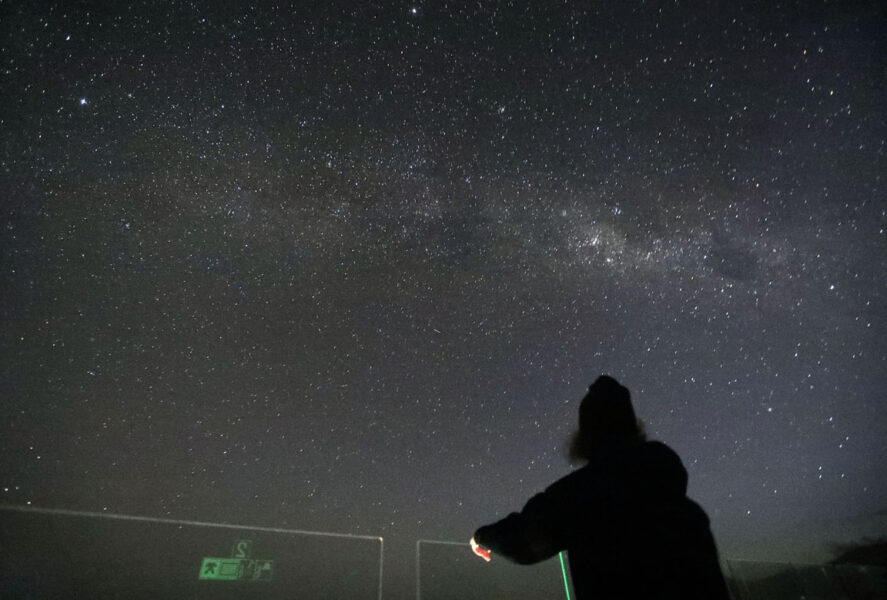
Bob King
Last December I joined Sky & Telescope Senior Editor Kelly Beatty on a solar eclipse cruise to Antarctica. While the eclipse was clouded out, we scored four nights of mostly clear skies farther north in the Falkland Islands, which were also on the ship's itinerary. Because of nightlong twilights I saw only Sirius and Canopus from Antarctica, but Falkland skies delivered spectacular views of the southern Milky Way and the Magellanic Clouds.
From my home in Minnesota, the southern horizon cuts off the Milky Way a short distance below Canis Major. It felt so liberating to "keep on going" and follow the starry flow onward through Vela and Crux all the way to Norma. Despite the loss of the Sagittarius-Scorpius section to solar glare, I really got a sense of the Milky Way as a circle rather than a band. Although I knew this for a fact, it had taken years to experience it firsthand.
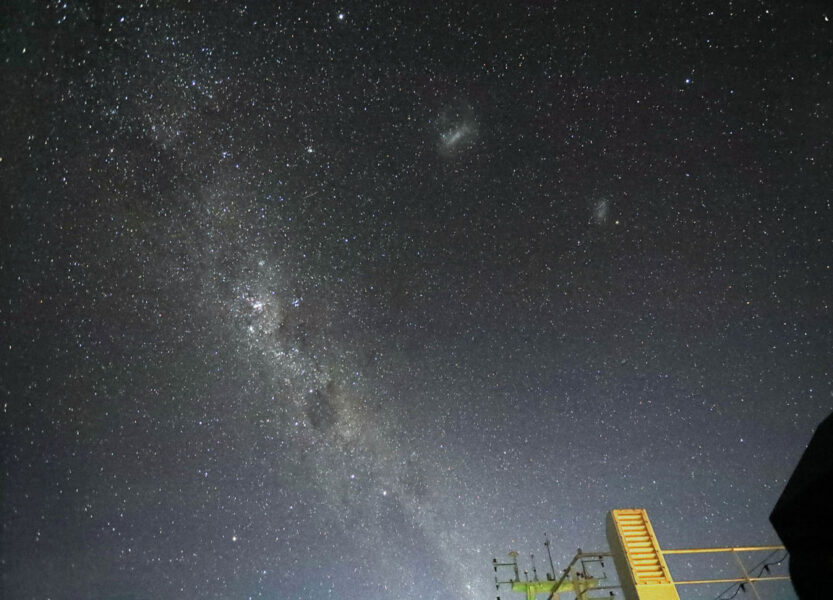
Bob King
While the ribbon of the southern Milky Way wasn't particularly wide, it was strewn with bright stars and chock-a-block with clumpy star clouds, dark nebulae, and well-known naked-eye gems like the Eta Carina Nebula, the Southern Pleiades (IC 2602), and the Coal Sack Nebula — a far cry from the more subtle appearance of the northern winter band. The puffy Magellanic Clouds stood at anchor a safe distance from the Milky Way's starry shoals. I saw all these sights and more with just the naked eye aided by a pair of 8×24 binoculars.
A week later, I returned home. Funny how quickly you get used to celestial objects wheeling around in the opposite direction from the Southern Hemisphere. My first sight of the Moon was quite a surprise — for just a moment it looked upside down!
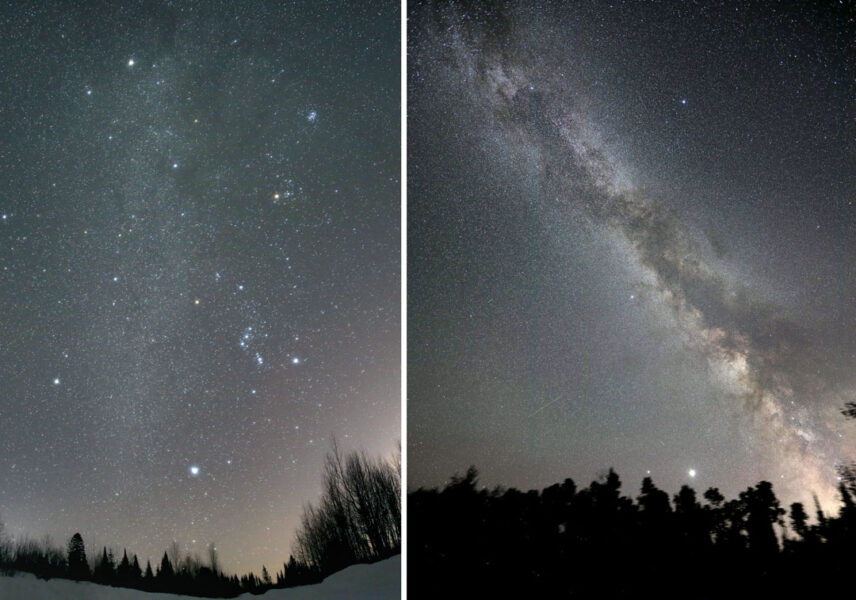
Bob King
After heaping eyefuls of the summer southern Milky Way I was eager to compare it with its northern cousin. The winter Milky Way gets short shrift because it's fainter and less impressive than the bright, flocculent summer half that runs from Cygnus through Sagittarius. There's good reason why. On winter nights, we face away from the galactic center in Sagittarius and instead look outward. Stars thin out across the galaxy's flattened disk until our gaze meets the abyss of intergalactic space.
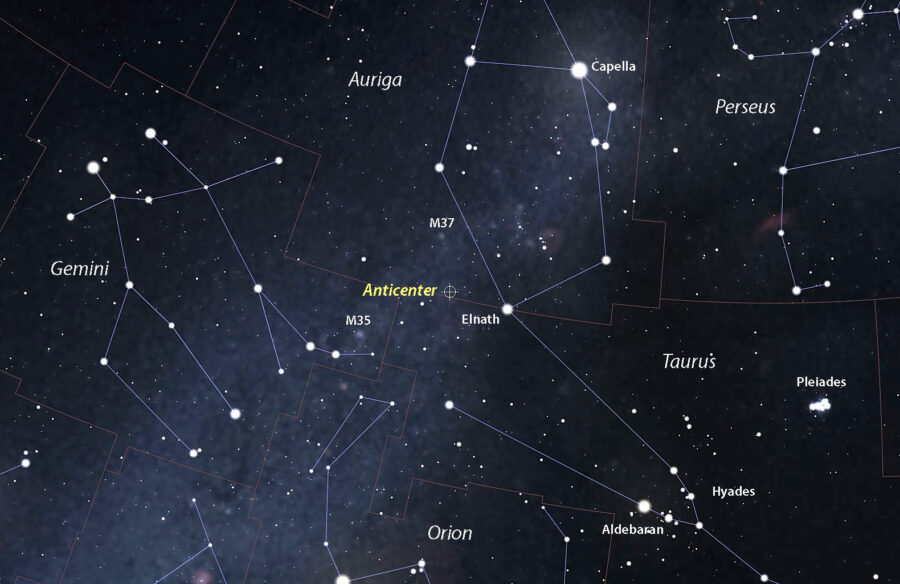
Stellarium
The point directly opposite the Milky Way's center, called the anticenter, is located in Auriga 4° northeast of Beta (β) Tauri (Elnath). Face this direction, and the edge of the galaxy looms about 26,000 light-years away. From February 18th through March 7th, the Moon will be absent from the evening sky and the Milky Way well placed for observation at nightfall. Along the way, we'll compare and contrast it with the summer southern half.
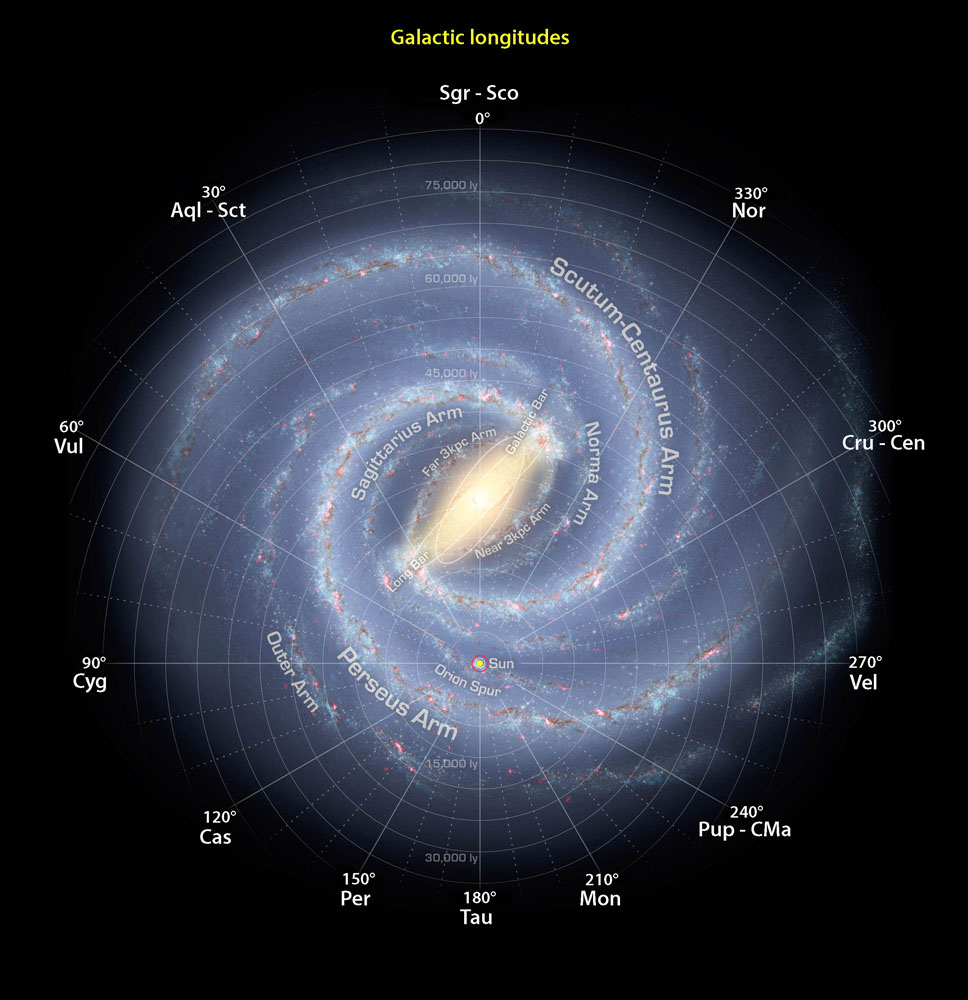
NASA/JPL-Caltech/R. Hurt (SSC/Caltech) with additions by Bob King
Let's start by catching the tail end of the band in Cepheus low in the northwestern sky. A distinct wisp or curl of Milky Way extends north of the band into the southern half of Cepheus. This area is home to the massive emission nebula/star-forming region IC 1396 and a number of attractive open clusters. From here through Cassiopeia's W the Milky Way appears bright, relatively narrow, and well-defined, much like the Vela-to-Crux region in the Southern Hemisphere.

Dylan O'Donnell (left) and ESO/S. Brunier
Similar to the Eta Carinae Nebula, the Double Cluster (NGC 884 and NGC 869) is easily visible with the naked eye, appearing as a fuzzy knot 1° across near the border with Perseus. This and many other star clusters and nebulae within Cassiopeia's borders gleam from the outer Perseus Arm of the galaxy, far from our cozy home in the Orion Spur.
While the stars of the W and Perseus add sparkle to this section of the Milky Way, its southern counterpart possesses many more bright luminaries including four 2nd-magnitude suns in Vela, three in Carina, and five 1st-magnitude or brighter stars between Crux and western Centaurus. Southern Hemisphere observers not only have the best view of the galactic center, which passes overhead from central South America, southern Africa, and Australia during their winter, but their summer brings Orion, Crux, Eta Carinae, and much more.
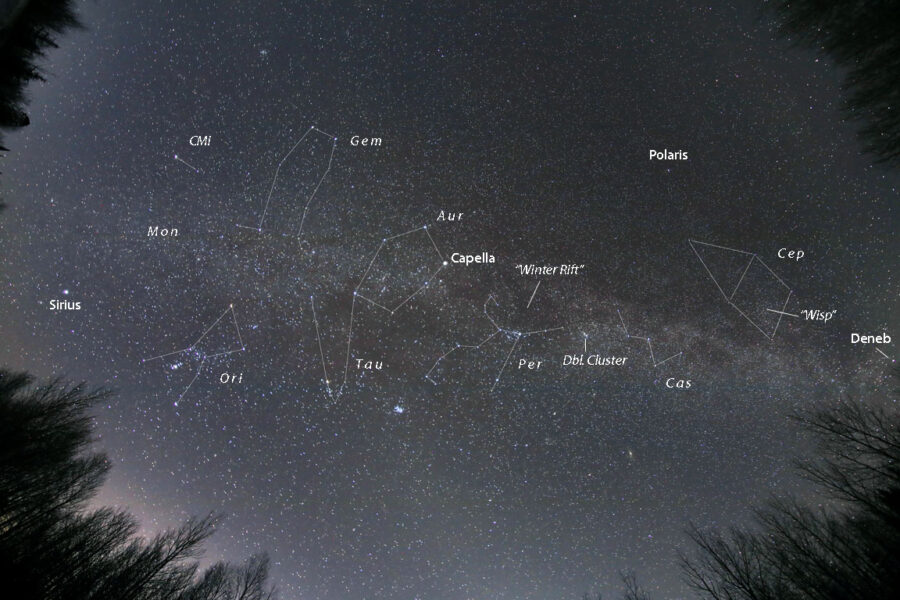
Bob King
As we approach Perseus, the band quickly fades and splits into two branches — a narrow, brighter tributary that flows across Mirfak and the Alpha Persei Cluster, and a broad but much fainter flow lapping the constellation's northern border. Like the Great Rift in the summer Milky Way, apparent gaps in the band are really draperies of interstellar dust clouds floating in the foreground, blocking the light of more distant suns. Given this one's prominence I nicknamed it the Winter Rift.
In Auriga, the Milky Way band becomes continuous again and nicely contained by the constellation's pentagonal outline. All three bright open clusters here — M36, M37, and M38 — lie between 3,500 and 4,500 light-years away within the Perseus Arm.
After leaving Auriga, the Milky Way spills into Gemini, then broadens and becomes more diffuse as it flows through Orion and Canis Major. Familiar favorites like the open clusters M35, M46, M47, and the Orion Nebula light up the Orion Spur and lie relatively close to Earth.
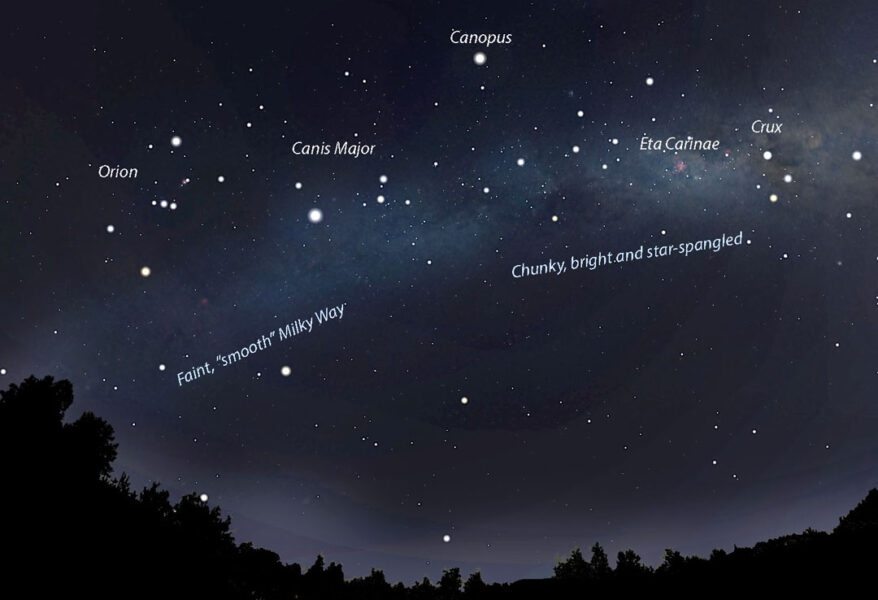
Stellarium
One of the most interesting sections of Milky Way band runs from northern Orion through Canis Major. From mid-northern latitudes it appears uniformly diffuse, broad and faint. Although Sirius and Betelgeuse appear along its edge, not a single bright star mars the faint, silky-smooth sheen of the main band. From the Falkland Islands the contrast between this section and the dazzling run from Vela to Norma was forcefully apparent. If you start at Orion and follow the band south the transition occurs in Puppis just south of Canis Major.
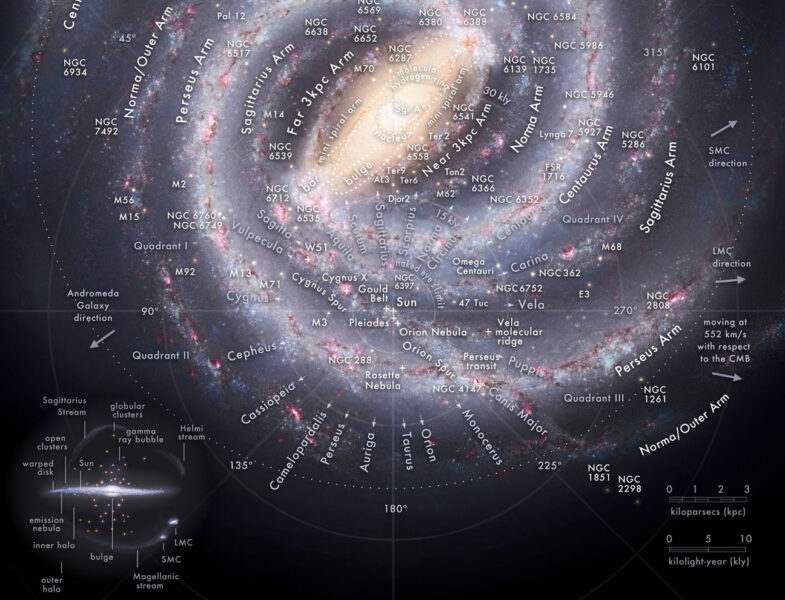
Created by Pablo Carlos Budassi
So why is that, I wondered? Consulting Milky Way maps, it's evident that when we face the faint Monoceros–Puppis segment, we're looking through the Orion Spur and outward into the Perseus Arm. Turning toward Vela and Carina, our line of sight crosses an inter-arm gap before entering the Sagittarius and Centaurus Arms. We're now facing more in the direction of the galactic center. At the same time we're looking down the Sagittarius Arm. This creates a stacking effect that not only increases the brightness of the Milky Way band but also the number of nebulae (bright and dark) and clusters visible with the naked eye.
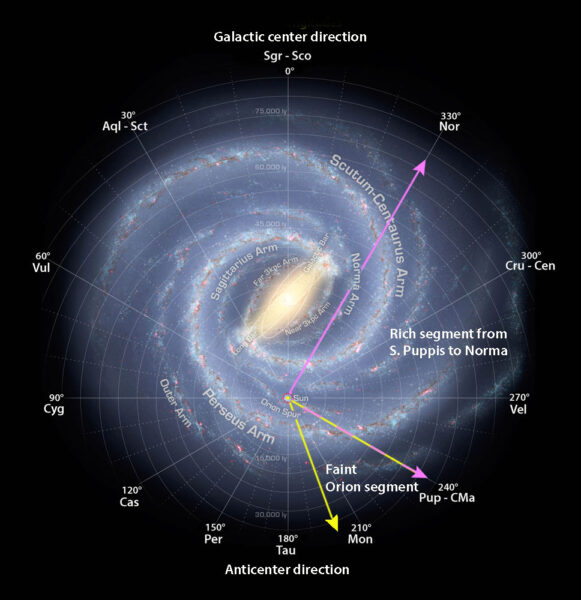
NASA/JPL-Caltech/R. Hurt (SSC/Caltech) with additions by Bob King
But one question still gnaws at me. The bright stars that adorn the stretch from Vela through Centaurus are mostly nearby suns located in the Orion Spur. Why don't we see a similar bouquet of bright stars from Monoceros to Puppis? Then I'm reminded of why we look up in the first place. Not only to experience wonder but to wonder. Happy galactic travels!
 6
6









Comments
Chris-Schur
February 17, 2022 at 5:55 pm
Fantastic article Bob! I still am shocked at how we can get ISO 25,000 on those new dslr's. In the old film days, getting a roll of 3200 asa film was always an experience in monster sized grain! Digital has changed the face of amateur astro imaging.
You must be logged in to post a comment.
Bob KingPost Author
February 18, 2022 at 10:32 am
Hi Chris,
Thanks very much! So true about the old days when 3200 meant horrible grain. I'd never used ISO 25,600 before until I was confronted with the reality of doing time exposures on a moving ship. I didn't WANT to go that high but had not choice. I'm thinking of buying one of those gyro mounts if I find myself in a similar situation again, but I'd love to return to the southern hemisphere and photograph on solid ground. What a luxury!
You must be logged in to post a comment.
Russ
February 18, 2022 at 4:06 pm
Thanks so much, Bob. I've never been as aware of our place the galaxy until your interesting analysis. Even the Milky Way face on view of the Sun in our galaxy was not very familiar to me. That astronomers are able to discern the barred spiral morphology and the various spiral arms is quite amazing. And your investigation as to why the Milky Way looks as it does to us is most informative. Understanding why an object appears as it does is mind-blowing considering we are inside that object! Thanks for your report. It is much appreciated.
Russ
You must be logged in to post a comment.
Bob KingPost Author
February 19, 2022 at 12:18 am
Thank you, Russ. I appreciate that. It all started really with "seeing how the other half lives" during that Antarctic trip. You can see photos of the Milky Way in a book or online, but the in-person experience was both beautiful and inspirational.
You must be logged in to post a comment.
Joe
February 19, 2022 at 10:39 am
Great article, Bob! I really enjoyed the diagrams showing our sight lines through the Milky Way.
You must be logged in to post a comment.
Bob KingPost Author
February 19, 2022 at 11:08 am
Thanks, Joe! I'm glad it helped provide context.
You must be logged in to post a comment.
You must be logged in to post a comment.